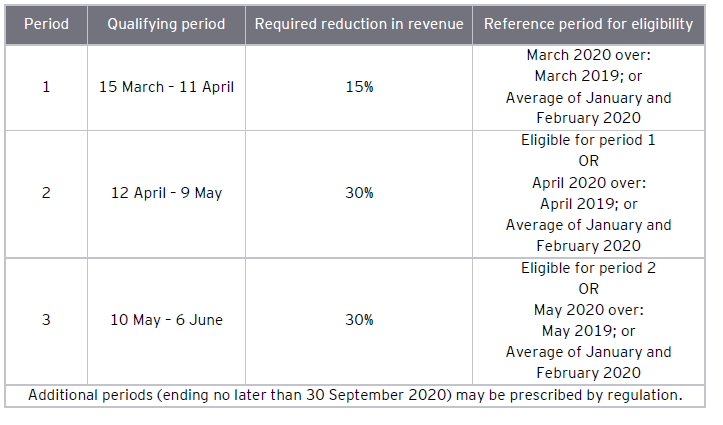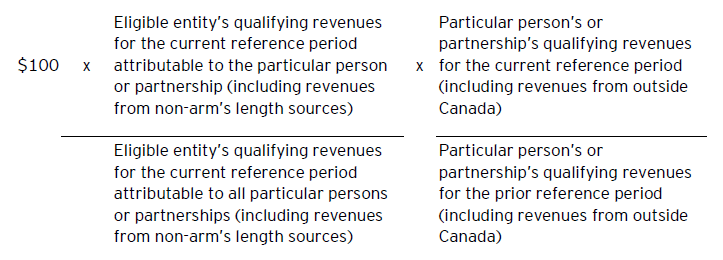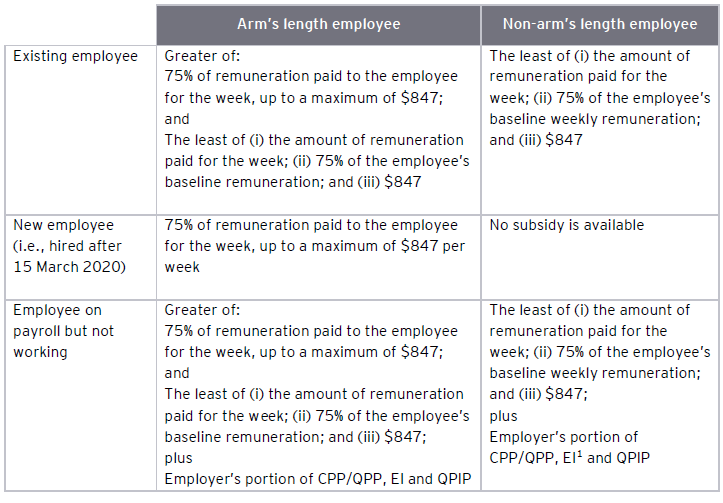
Canada Emergency Wage Subsidy legislation receives Royal Assent ‑ COVID‑19
Tax Alert No. 30, 14 April 2020
On 1 April 2020, Finance Minister Bill Morneau introduced a new program called the Canada Emergency Wage Subsidy (CEWS), to co-exist with the 10% wage subsidy previously announced (see EY Tax Alert 2020 No. 28 for details).
On 8 April 2020, the Finance Minister announced further revisions to expand the eligibility criteria for the CEWS and shared critical information that was previously not addressed. See EY Tax Alert 2020 No. 29.
On 11 April 2020, the CEWS as part of Bill C-14 received Royal Assent.
Bill C-14 implements the 75% CEWS.
Key amendments (either announced on 8 April or only added on 11 April 2020) include:
- Reduction to 15% of the required reduction in revenue for March 2020 (instead of 30%) to be eligible for the subsidy;
- Ability to compare the average of monthly revenue earned in January and February 2020 instead of using the general year-over-year approach to measure the revenue loss;
- Rules around calculating changes in revenue where revenue is received from non-arm’s length sources;
- Ability to use the cash method to determine qualifying revenue;
- Interaction with the Work-Sharing program;
- Addition of the 100% refund for certain payroll contributions;
- Enhanced anti-avoidance provisions; and
- Enhanced penalty provisions.
Eligible entities
The categories of eligible entities for the CEWS are broad. Eligible entities encompass employers of all sizes, across all sectors of the economy (including non-profit organizations, fraternals, registered charities and eligible partnerships) with the exception of public institutions. The legislation provides that additional categories of organizations may be prescribed by regulation.
Public companies and foreign-headquartered companies that employ employees in Canada can qualify.
For an eligible entity to qualify for the CEWS, it must also have had a payroll (RP) account with the Canada Revenue Agency (CRA) on 15 March 2020.
Remuneration
Subject to the discussion below under “Anti-avoidance rules”, eligible remuneration generally comprises salary, wages and other employment benefits (including taxable benefits), including commissions, with the exception of retiring allowances (severance pay) and benefits arising where an employer or related corporation has agreed to sell or issue securities to an employee.
Calculating reduction in gross revenues
Only employers who suffer the requisite reduction in revenues for the relevant “reference period” in 2020 when compared to the “prior reference period” will be eligible for CEWS.
A summary of the reference periods is set out below.


Once an employer is determined to be eligible for a specific qualifying period, the employer will also qualify for the next period of the program. For example, an eligible entity that suffers the requisite reduction in revenue in March 2020 when compared to March 2019 (or alternate prior reference period) would be eligible for the CEWS in respect of remuneration paid to eligible employees during periods 1 and 2 (i.e., period 1 that runs from 15 March – 11 April and period 2 that runs from 12 April – 9 May).
Revenue test
In order for an eligible entity to qualify, there must be a minimum 15% or 30% drop in “qualifying revenue”, depending on the relevant qualifying period (i.e., as outlined above).
Calculating “qualifying revenue”
What is revenue?
An entity’s qualifying revenue is generally the entity’s revenue arising in the course of its ordinary activities in Canada and earned from arm’s length sources. The inflow of cash, receivables or other consideration arising in the course of the ordinary activities of the eligible entity — generally from the sale of goods, the rendering of services and the use by others of resources of the eligible entity — is included in qualifying revenue.
Qualifying revenue excludes extraordinary items, the CEWS (received or receivable) and the 10% wage subsidy.
For charities, qualifying revenue includes gifts, donations and other amounts received in the course of its ordinary activities. Charities can elect to exclude funding received from government sources, but the choice will apply to all qualifying periods.
Methods of calculating revenue
The starting point is that revenue is to be calculated using the entity’s normal accounting practices. However, as described below, there are some exceptions.
Accrual vs. cash basis
A majority of entities determine revenue on an accrual basis; however, the legislation permits entities to elect to determine revenue on a cash basis. Where an election is made to determine revenue on a cash basis, the cash method must be used for purposes of determining revenue for all qualifying periods.
Corporate and affiliated groups
The legislation contains flexibility to determine changes in revenue at an individual entity level or on a consolidated basis in accordance with relevant accounting principles. In this regard, various options are available.
In situations where a group of entities normally prepare financial statements on a consolidated basis, the legislation provides members with the ability to determine revenue separately, as long as every member of the group determines its revenues on that basis.
Conversely, each member of an affiliated group of eligible entities will also be entitled to use the qualifying revenue of the group determined on a consolidated basis (in accordance with relevant accounting principles), as long as each member of the group jointly elects to do so.
All members are thus required to agree on adopting the same methodology, meaning that either all members determine their revenues separately or revenues are to be determined on a consolidated basis.
Joint ventures
Where all the interests in an eligible entity are owned by participants in a joint venture, and all or substantially all (i.e., generally 90% or more) of the qualifying revenues of the eligible entity for a qualifying period are in respect of the joint venture, the eligible entity will be entitled to use the qualifying revenues of the joint venture rather than its own qualifying revenues.
Non-arm’s length parties
In the case of non-arm’s length parties (i.e., shared services organizations, marketing companies, etc.), the legislation generally provides that the revenue test is only met in situations where there is the requisite decline in arm’s length revenues in the related entities.
Where all or substantially all of an eligible entity’s qualifying revenues (including revenues from non-arm’s length sources) for a qualifying period are from one or more particular non-arm’s length persons or partnerships, and each particular person or partnership jointly elects with the eligible entity, the eligible entity’s qualifying revenues for the current reference period (i.e., March, April or May 2020) will be determined by applying the following formula to each particular person or partnership and aggregating the results:

The result of this aggregation will be compared to the eligible entity’s gross revenues for the prior reference period, which will be deemed to be $100. As previously announced, the prior reference period is the corresponding March, April or May 2019, or alternatively, January to February 2020.
For example, assume the eligible entity’s qualifying revenues for the qualifying period of March 2020 are $98,000; $95,000 (i.e., more than 90%) is attributable to two non-arm’s length particular persons ($60,000 from XCo and $35,000 from YLLP), and XCo’s and YLLP’s qualifying revenues for the current reference period (March 2020) and prior reference period (March 2019) are respectively $100,000 and $180,000, and $80,000 and $140,000. The eligible entity’s deemed qualifying revenues for the qualifying period of March 2020 would be $56 (i.e., [($100 x $60,000/$95,000 x $100,000/$180,000) + ($100 x $35,000/$95,000 x $80,000/$140,000)], which will be compared to $100. In this example, the eligible entity would be a qualifying entity for the CEWS since its deemed qualifying revenues for the current reference period of March 2020 (i.e., $56) would be less than $85 (i.e., 85% of its deemed qualifying revenues for the prior reference period of March 2019 (i.e., $100), thereby showing a decline in revenues of at least 15%.
Certification
In order to be eligible for the CEWS, the eligible entity must file an application in prescribed form on or before 30 September 2020. We understand that the application will be made through the CRA’s web portal (My Business Account).
The individual who has principal responsibility for the financial activity of the eligible entity is required to attest that the application is complete and accurate. In most cases, it is expected that this would be the chief financial officer of the eligible entity.
Interaction with the Canada Emergency Response Benefit (CERB)
Employers are not eligible to receive the subsidy in respect of remuneration paid to employees who are eligible for the CERB for the same period. Employers will generally not qualify for the subsidy in respect of a particular employee in situations where the employee is out of work for at least 14 consecutive days in the qualifying period. In effect, this may mean that the subsidy is not available where there is a layoff of an employee in a prior period and the employee is rehired 14 or more days after the beginning of the qualifying period.
Based on verbal guidance from CRA, we understand that employees can however be paid retroactively such that an employee will be viewed as having received income in respect of the 14-day period and thus, no longer be eligible for the CERB. It remains to be seen how repayments will be dealt with administratively where employees have previously received amounts under the CERB.
Anti-avoidance rules
The wage subsidy represents a very substantial government expenditure, and the government recognizes that there are several opportunities for abuse. It is therefore not surprising that the legislation contains several anti-avoidance rules and enhanced penalties.
The wage subsidy will not apply in respect of any of the following payments to employees:
- Any amount received by an employee that can reasonably be expected to be paid or returned, directly or indirectly, to the employer, any non-arm’s length person, or anyone at the direction of the employer. Artificial schemes where amounts are paid to employees on the understanding that all or a part of the amount will be returned to the employer or related persons will not qualify.
- Where the employee was employed before 15 March 2020, the wage subsidy does not apply to remuneration in excess of the employee’s baseline remuneration if it is reasonably expected that after the qualifying period the employee’s remuneration will be lower than their weekly baseline remuneration and one of the main purposes of the arrangement is to increase the employer’s CEWS. “Baseline remuneration” is the employee’s average weekly remuneration for the period from 1 January 2020 to 15 March 2020 (i.e., any period of seven or more consecutive days during which the employee did not earn any income is excluded from the calculation). Therefore, this rule is designed to prevent employers from artificially inflating wages to take advantage of the wage subsidy.
Amount of the subsidy (per week)

1 Employment of a person who does not deal at arm’s length with the employer may be deemed to be insurable employment and subject to EI premiums if the employment meets the criteria in paragraph 5(3)(b) of the Employment Insurance Act.
The CEWS amounts above are reduced to the extent the employer applies the 10% wage subsidy in respect of a particular employee. The CEWS is also reduced in respect of a particular employee to the extent that the particular employee receives Employment Insurance (EI) benefits for the week under a work-sharing plan.
The employee must be on payroll and paid during the period between 15 March 2020 and 6 June 2020 in order for the employer to be eligible for the CEWS.
There is no cap on the aggregate amount that may be paid to a particular qualifying entity.
Refund for certain payroll contributions
The CEWS includes a 100% refund for certain employer-paid contributions to EI, Canada Pension Plan (CPP), Quebec Pension Plan (QPP) and the Quebec Parental Insurance Plan (QPIP). The refund covers the contributions made by employers for each week applicable employees are on leave with pay (where the employer is eligible to claim the CEWS).
An employee is considered to be on leave with pay if they receive remuneration from the employer for the week but do not perform work. The refund is not available for employees that are only on leave for part of a week.
Employers are still required to withhold and remit employer and employee contributions to the above-noted programs as usual, but may thereafter apply for the refund. The refund is separate from the $847 maximum benefit amount that employers can claim in respect of the CEWS, and there is no overall limit to the refund that an eligible employer may claim.
Limitations
If an employee is employed by two or more qualifying entities for a particular week that do not deal at arm’s length, maximum CEWS for that employee in respect of that week is the amount that would arise if the employee was paid by one qualifying entity.
Penalties
Manipulating revenue
There are penalties for attempting to manipulate revenue in order to qualify for the CEWS. Where an entity or non-arm’s length person undertakes an action (or omission) that has the effect of reducing the eligible entity’s qualifying revenue for the current reference period and it is reasonable to conclude that the main purpose for the act or omission was to cause the eligible entity to qualify for the CEWS, the eligible entity is subject to a penalty of 25% of the amount claimed. However, this rule excludes actions already permitted under the legislation, such as choosing one of the methods for the computation of qualifying revenues referred to above.
Gross negligence penalty
If an eligible entity claims the CEWS and knowingly or under circumstances amounting to gross negligence has made or participated in, assented to or acquiesced in the making of a false statement or omission in a return, form certificate, statement or answer filed or made in respect of a taxation year, the entity is liable to a penalty of 50% of the CEWS overpayment.
This gross negligence penalty is in addition to the 25% penalty.
Offence provisions
Anyone who obtains or claims a refund or credit to which the person or any other person is not entitled or obtains or claims a refund or credit greater than that to which they are entitled by making, participating in, assenting to or acquiescing in the making of a false or deceptive statement is guilty of an offence. Depending upon the circumstances, prosecutors are able to choose to proceed by way of either a summary or indictable offence. Penalties are as follows:
Summary Conviction: Fine of 50% to 200% of CEWS, or fine + imprisonment of up to two years
Indictment: Fine of 100% to 200% + imprisonment of up to five years
Disclosure of application for subsidy
The government has stated that they expect employers receiving the wage subsidy to use best efforts to pay employees’ wages at pre-crisis levels. While there is no explicit mention of this in the legislation, there is a provision that provides the Minister with the ability to disclose the names of all employers who apply for the wage subsidy. It is possible that one of the purposes of this enhanced disclosure is to use the prospect of negative public opinion to encourage employers who are able to pay employees at pre-crisis levels.
Observations
- Due to the size of the government expenditure, audit activity should be expected.
- Eligible employers must actually demonstrate payment made to employees.
- Consider interaction with the CERB, the 10% subsidy and EI work-sharing. When reinstating employees, consider doing so during the first 14 days of the qualifying period.
- In situations where is it not obvious that there is the requisite reduction in revenue, great care should be taken to ensure that there has been the requisite reduction in revenue before applying for the CEWS.
- Eligible entities may wish to undertake an analysis of whether to (i) elect to use the cash accounting method; and (ii) determine revenues on a stand-alone or consolidated basis.
- Employers should make best efforts to actually pay the remaining 25%. While this may not be a specific requirement in the legislation, employers using the CEWS should proceed on the basis that their identities will be made known to the public and could sustain reputational damage if they fail to pay the remaining 25% where they have the ability to do so.
- Eligible employers must keep records demonstrating the relevant reduction in revenue in each period.
Learn more
For more information, please contact your EY or EY Law advisor or one of the following professionals:
Toronto
David Steinberg
+1 416 932 6206 | david.a.steinberg@ca.ey.com
Lawrence Levin
+1 416 943 3364 | lawrence.levin@ca.ey.com
Edward Rajaratnam
+1 416 943 2612 | edward.rajaratnam@ca.ey.com
David Robertson
+1 403 206 5474 | david.d.robertson@ca.ey.com
Roxanne Wong
+1 416 943 2966 | roxanne.wong@ca.ey.com
Montréal
Stéphane Leblanc
+1 514 879 2660 | stephane.leblanc@ca.ey.com
Budget information: For up-to-date information on the federal, provincial and territorial budgets, visit ey.com/ca/Budget.

